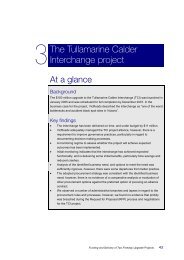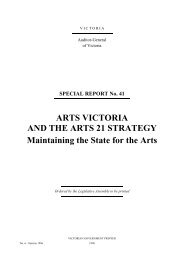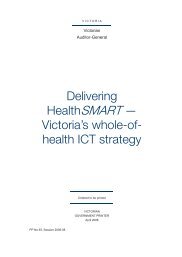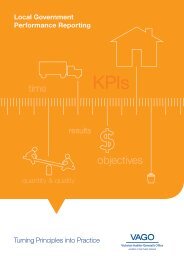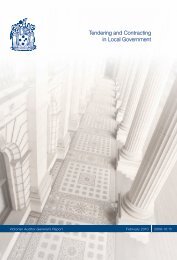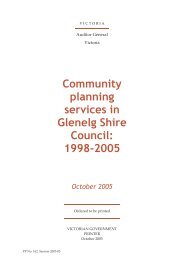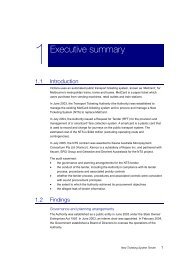New ticketing system tender
New ticketing system tender
New ticketing system tender
You also want an ePaper? Increase the reach of your titles
YUMPU automatically turns print PDFs into web optimized ePapers that Google loves.
1<br />
Executive summary<br />
1.1 Introduction<br />
Victoria uses an automated public transport <strong>ticketing</strong> <strong>system</strong>, known as ‘MetCard’, for<br />
Melbourne’s metropolitan trains, trams and buses. MetCard is a paper ticket which<br />
users purchase from vending machines, retail outlets and train stations.<br />
In June 2003, the Transport Ticketing Authority (the Authority) was established to<br />
manage the existing MetCard <strong>ticketing</strong> <strong>system</strong> and to procure and manage a <strong>New</strong><br />
Ticketing System (NTS) to replace MetCard.<br />
In July 2004, the Authority issued a Request for Tender (RFT) for the provision and<br />
management of a ‘smartcard’ fare collection <strong>system</strong>. A smartcard is a plastic card that<br />
is used to record and charge for journeys on the public transport <strong>system</strong>. The<br />
estimated cost of the NTS is $494 million (excluding operating costs and<br />
contingencies).<br />
In July 2005, the NTS contract was awarded to Keane Australia Micropayment<br />
Consortium Pty Ltd (‘Kamco’). Kamco is a subsidiary of Keane Inc. and partnered with<br />
Ascom, ERG Group and Geisecke and Devrient Australasia for the NTS project.<br />
The audit examined:<br />
• the governance and planning arrangements for the NTS <strong>tender</strong><br />
• the conduct of the <strong>tender</strong>, including the Authority’s compliance with its <strong>tender</strong><br />
process, procedures and associated probity controls<br />
• whether the <strong>tender</strong> process, procedures and associated controls were consistent<br />
with sound procurement principles<br />
• the extent to which the Authority achieved its procurement objectives<br />
• the alleged leak of <strong>tender</strong> information.<br />
1.2 Findings<br />
Governance and planning arrangements<br />
The Authority was established as a public entity in June 2003 under the State Owned<br />
Enterprises Act 1992. In June 2003, an interim chair was appointed. In February 2004,<br />
the Government established a Board of Directors to oversee the operations of the<br />
Authority.<br />
<strong>New</strong> Ticketing System Tender 1
Executive summary<br />
2 <strong>New</strong> Ticketing System Tender<br />
Between the release of the RFT (30 July 2004) and the Board’s recommendation of the<br />
successful <strong>tender</strong>er (10 June 2005), the Board met nine times. The conduct of the<br />
Board meetings and out-of-session briefings and approvals were consistent with<br />
contemporary approaches to corporate governance.<br />
While the Board was expanded late in the <strong>tender</strong> process to comprise three members<br />
(the statutory limit is five members), for most of the <strong>tender</strong> period the Board consisted<br />
of two members. Given the size and complexity of the <strong>tender</strong>, a larger Board was<br />
warranted.<br />
The Authority established an Audit Committee with two members to assist the Board.<br />
At the time of the NTS <strong>tender</strong>, these two individuals were also members of the Board.<br />
A larger Audit Committee, with at least one external member, would have<br />
provided a higher degree of assurance about the Authority’s governance,<br />
compliance and performance.<br />
The Authority established an evaluation committee comprising five senior executives<br />
from the Authority, the Authority’s senior legal advisor, and representatives from the<br />
Departments of Treasury and Finance and Infrastructure. The evaluation committee<br />
was supported by five advisory teams comprising Authority staff, external experts and<br />
advisors. Four senior Authority managers were members of both the evaluation<br />
committee and one or more advisory committees. The accountability arrangements<br />
would have been strengthened had the senior managers participated in either<br />
the evaluation committee or the advisory teams but not both.<br />
In a major <strong>tender</strong>, the role of a Probity Advisor is to establish and manage the probity<br />
approach, while the role of a Probity Auditor is to independently review the nature and<br />
conduct of the probity approach. In the case of the NTS <strong>tender</strong>, the Probity Auditor and<br />
Probity Advisor roles were combined. While combining the roles may benefit a<br />
<strong>tender</strong>ing authority through cost savings and efficiencies, having a separate<br />
Probity Auditor role provides a higher level of assurance about the standard of<br />
<strong>tender</strong> probity. Combining the roles serves to confuse accountabilities and may<br />
weaken public confidence in the probity of a <strong>tender</strong>.<br />
As a non-departmental public entity, the Authority was not required to comply with the<br />
<strong>tender</strong>ing guidelines issued by the Minister for Finance, the Department of Treasury<br />
and Finance and the Victorian Government Purchasing Board (VGPB). The Authority<br />
had adequate policies and procedures in place to ensure compliance with the<br />
VGPB guidelines.<br />
The Authority began planning the NTS <strong>tender</strong> in late 2003, building on a significant<br />
body of research undertaken by the Authority’s precursor, the Public Transport<br />
Ticketing Taskforce. The Authority’s planning for the NTS <strong>tender</strong> was completed before<br />
the initial date for the close of <strong>tender</strong>s. The essential plans, processes and<br />
administrative arrangements were all in place when the NTS <strong>tender</strong> commenced.
Management of the NTS <strong>tender</strong><br />
Executive summary<br />
There are only a small number of suppliers of automated <strong>ticketing</strong> <strong>system</strong>s worldwide.<br />
Two major equipment suppliers dominate the Australian market. Most of the <strong>ticketing</strong><br />
<strong>system</strong>s acquired around the world have involved a long-term contract for the supply of<br />
a proprietary <strong>system</strong>. Such arrangements have created technical barriers to<br />
purchasing authorities, with respect to:<br />
• obtaining the best <strong>ticketing</strong> <strong>system</strong><br />
• changing equipment or suppliers during the contract period if the <strong>system</strong>s and<br />
equipment fail to operate as required.<br />
The NTS procurement approach was designed to overcome these problems by:<br />
• breaking the <strong>system</strong> into a number of separate components<br />
• establishing a <strong>system</strong> where component parts were interchangeable (through the<br />
use of open architecture).<br />
Rather than providing detailed specification requirements, the Authority set out desired<br />
outputs and outcomes and gave the <strong>tender</strong>ers considerable flexibility in how to meet<br />
the desired outputs and outcomes.<br />
Audit assessed the NTS <strong>tender</strong> against the high-level objectives that were being<br />
sought from the <strong>tender</strong>, namely:<br />
• high levels of performance<br />
• timeliness and smooth transition<br />
• <strong>system</strong>s flexibility<br />
• value for money.<br />
Audit found that the <strong>tender</strong> process was largely successful in meeting the<br />
Authority’s objectives:<br />
• the Authority established a procurement process which emphasised customers’<br />
requirements and the selection of a solution that would provide for the future<br />
needs of the Victorian community<br />
• the procurement phase of the NTS project was timely when compared with other<br />
<strong>ticketing</strong> <strong>tender</strong>s in Australia and overseas<br />
• transition to the new <strong>system</strong> should be assisted by the transitional agreement<br />
established between the Authority and the current operator. Also, transition is<br />
likely to be facilitated by the fact that the current <strong>ticketing</strong> operator is involved in<br />
the successful <strong>tender</strong>er’s consortium<br />
• the <strong>tender</strong> process adopted by the Authority enabled it to attract more <strong>tender</strong>s<br />
than other comparable <strong>ticketing</strong> projects had received<br />
• the contract price submitted by the successful <strong>tender</strong>er was within the budget set<br />
by the State Government and satisfied the Authority’s internal benchmark. The<br />
procurement process was successful in reducing the <strong>tender</strong> prices initially<br />
submitted by around 35 to 40 per cent. It is likely that, if the selected <strong>tender</strong> is<br />
delivered as agreed, value for money will be achieved.<br />
<strong>New</strong> Ticketing System Tender 3
Executive summary<br />
4 <strong>New</strong> Ticketing System Tender<br />
Audit also assessed the key elements of the Authority’s management of the NTS<br />
<strong>tender</strong>, namely:<br />
• the resourcing of the <strong>tender</strong> management team<br />
• steps taken to inform potential <strong>tender</strong>ers about what was being sought, the<br />
procurement approach and the <strong>tender</strong> process<br />
• management of changes to the <strong>tender</strong> process and requirements<br />
• the evaluation of <strong>tender</strong>s<br />
• the conduct of negotiation with one or more shortlisted <strong>tender</strong>ers, and clarification<br />
of the shortlisted <strong>tender</strong>s<br />
• documentation of the <strong>tender</strong> process.<br />
Audit identified a number of areas of good practice, as well as areas for<br />
improvement and lessons for wider application to future major <strong>tender</strong>s.<br />
The Authority engaged sufficient staff with <strong>ticketing</strong> and <strong>tender</strong>ing experience, and the<br />
<strong>tender</strong> team had sufficient access to specialist services and skills.<br />
The Authority conducted market soundings in January and May 2004. The soundings<br />
were an effective way of informing potential <strong>tender</strong>ers about the goods and services<br />
being sought, other aspects of the <strong>tender</strong> requirements, and the proposed<br />
procurement approach. Up to the receipt of initial offers, the Authority successfully<br />
communicated with <strong>tender</strong>ers and potential <strong>tender</strong>ers about the solution being sought<br />
and the nature of the <strong>tender</strong> process.<br />
After the receipt of low-quality initial offers, the Authority implemented an interactive<br />
approach (which was permitted by the RFT). The process was unfamiliar to several<br />
<strong>tender</strong>ers. While the Authority and the Probity Auditor took extensive steps to keep all<br />
<strong>tender</strong>ers well informed, some <strong>tender</strong>ers told audit that they needed more information<br />
about the process as it evolved. Also, despite the steps taken to inform the market,<br />
some <strong>tender</strong>ers did not fully appreciate the implications of the ‘outcomes’ approach to<br />
the <strong>tender</strong>. Additional steps could have been taken to:<br />
• apprise <strong>tender</strong>ers of the procurement approach, and its implications for the<br />
<strong>tender</strong> requirements and compliance requirements<br />
• revisit the control framework and risk framework in light of the evolving approach.<br />
During the negotiation stage, approximately 54 Authority staff, consultants,<br />
departmental staff and transport operator staff had direct access to <strong>tender</strong>ers (the<br />
majority of the access was through clarification sessions rather than negotiation<br />
meetings). While the subject matter of the <strong>tender</strong> and the clarification sessions<br />
necessitated a high degree of involvement of technical specialists, the number<br />
of people with direct access to <strong>tender</strong>ers was high. This increased the risk of<br />
uncontrolled information flows.<br />
A three-part <strong>tender</strong> rating <strong>system</strong> was used in the NTS <strong>tender</strong>. The rating <strong>system</strong><br />
did not indicate the difference between <strong>tender</strong>s within each category, and did not<br />
provide a precise assessment of how close each <strong>tender</strong> was to meeting the<br />
<strong>tender</strong> requirements. A more fine-grained <strong>system</strong> would have:
Executive summary<br />
• shown more meaningfully the relative position of <strong>tender</strong>s<br />
• allowed the Authority to more clearly match the assigned rating to the<br />
evaluation narrative<br />
• given a clearer representation of the progress of <strong>tender</strong>s over time.<br />
While the NTS <strong>tender</strong> evaluation reports identified the areas where <strong>tender</strong>s did not<br />
meet the RFT requirements, the reports did not articulate which requirements were<br />
critical or threshold issues and which were not. For those requirements that were<br />
negotiable to some extent, this extent was not specified. The clear articulation of a<br />
maximum acceptable level of risk acceptance by government would have<br />
enabled the decision-makers to determine with more precision and confidence<br />
whether the departures from the RFT requirements were minor, or whether they<br />
were such that the desired solution could not be acquired within the budget<br />
without an unacceptable allocation of risk.<br />
Probity of the NTS <strong>tender</strong><br />
While flexible and innovative approaches to <strong>tender</strong>ing can enhance value for money<br />
for public procurers, the importance of probity is just as great in new types of <strong>tender</strong>ing<br />
as it is in traditional procurement processes.<br />
Due to the specialised nature of <strong>ticketing</strong> <strong>system</strong>s, it was highly likely that a number of<br />
Authority staff would have potential conflicts of interest from prior experience with<br />
organisations <strong>tender</strong>ing for the NTS project. The Probity Auditor identified more than<br />
30 staff and other individuals involved in the <strong>tender</strong> evaluation process who had<br />
potential conflicts of interest. Seven staff members and one consultant were rated as<br />
high risk. Most of the conflicts of interest resulted from previous work histories and/or<br />
shares in two companies included in consortia <strong>tender</strong>ing for the NTS.<br />
All shareholdings were disclosed to the Authority in conflict of interest statements<br />
signed by staff and consultants and were identified in the work undertaken by the NTS<br />
Probity Auditor. All of the declared shareholdings were modest and most were<br />
immaterial.<br />
The most significant shareholding of relevance to the <strong>tender</strong> was the CEO’s<br />
shareholding in Headstrong / James Martin & Co. The shareholding’s potential to<br />
damage community confidence in the <strong>tender</strong> was high. The Authority could have taken<br />
additional steps to address perceived conflicts in relation to the shareholding.<br />
Some senior Authority managers had shared work histories with a number of members<br />
of the <strong>tender</strong>ing consortia. These shared work histories and other relevant<br />
relationships were disclosed to the Authority. The Authority informed <strong>tender</strong>ers about<br />
those people in the Authority who had prior experience with <strong>tender</strong>ers.<br />
The Authority identified the conflicts of interest in a timely way. Audit found no evidence<br />
of corruption in the NTS <strong>tender</strong>, and no evidence that the conflicts of interest led to the<br />
unfair or biased treatment of particular <strong>tender</strong>ers or groups of <strong>tender</strong>ers. Nevertheless,<br />
the Authority could have taken additional steps to communicate to <strong>tender</strong>ers, the<br />
<strong>New</strong> Ticketing System Tender 5
Executive summary<br />
6 <strong>New</strong> Ticketing System Tender<br />
government and the community, how it was managing the real and perceived conflicts<br />
that arose in the <strong>tender</strong>.<br />
In interactive <strong>tender</strong>s, the risks of inappropriate information flows are particularly high.<br />
In the case of the NTS <strong>tender</strong>, most communications were controlled according to the<br />
<strong>tender</strong> procedures. However, audit identified a number of instances where<br />
communications did not comply with the controls and protocols.<br />
During the initial offer stage of the <strong>tender</strong>, the Authority removed the requirement in its<br />
probity plan for the Probity Auditor to attend all meetings with <strong>tender</strong>ers, including<br />
overseas site visits and workshops. The requirement was replaced with attendance<br />
‘as required’. No guidance was put before the senior management or the Board<br />
as to how this discretionary attendance was to be implemented. Such guidance<br />
would have strengthened probity oversight of the <strong>tender</strong>.<br />
Audit identified only two instances of email miscommunication during the NTS <strong>tender</strong>,<br />
which is insignificant in view of the high level of email communication during the<br />
<strong>tender</strong>. In addition, there was an incident in which a significant number of Authority<br />
documents, and one NTS <strong>tender</strong>er document not seen by the Authority, came into the<br />
possession of a journalist. Audit investigated the alleged leak and found that the<br />
Authority’s internal controls had limited access to the leaked documents to<br />
seven staff. Audit found no evidence that these staff members provided the<br />
documents to anyone outside the Authority.<br />
1.3 Recommendations<br />
Part 3: Governance and planning arrangements for the NTS <strong>tender</strong><br />
3.1 To achieve clarity and consistency in the application of procurement guidelines<br />
for major <strong>tender</strong>s, the coverage of the DTF and VGPB procurement guidelines<br />
should be expanded to cover non-departmental public entities’ major <strong>tender</strong>s in<br />
the same way that Departments are covered. ‘Major <strong>tender</strong>s’ should be defined<br />
as those with a value greater than $100 million or where a risk assessment<br />
indicates the <strong>tender</strong> is of a unique nature or is not ‘business as usual.’<br />
3.2 To provide greater assurance about the integrity of major <strong>tender</strong> processes, the<br />
guidelines should specify that, where major project procurement is to be<br />
undertaken by a special-purpose public entity, the size of the entity’s Board<br />
should reflect the scale and complexity of the project, and that to have at least<br />
three to four members on the Board, and at least one external member on the<br />
Board’s audit committee, is good practice. The guidelines should encourage<br />
agencies to make greater use of audit committees in the governance of major<br />
<strong>tender</strong>s.<br />
3.3 To keep up with new developments in <strong>tender</strong>ing, DTF should review biennially<br />
the applicable guidance materials for major <strong>tender</strong>s, including those materials<br />
relating to the governance and planning of major <strong>tender</strong>s.
3.4 DTF and the VGPB should amend their 2006 Policy for the Conduct of<br />
Executive summary<br />
Commercial Engagements in relation to Probity Auditors to provide that, for<br />
major and complex <strong>tender</strong>s:<br />
• Probity Auditor and Probity Advisor functions should be provided by different<br />
parties<br />
• where the procurement is being undertaken by a non-departmental public<br />
entity, the Probity Auditor should be engaged by the portfolio Department,<br />
with the <strong>tender</strong>ing authority reimbursing the Department for the cost of the<br />
Probity Auditor role at the end of the <strong>tender</strong> process.<br />
3.5 Non-departmental public entities undertaking major <strong>tender</strong>s should be required<br />
to use the probity services panel established by DTF. To facilitate this, DTF<br />
should review the membership of the panel and give suitable firms an<br />
opportunity to join the panel.<br />
Part 4: Management of the NTS <strong>tender</strong><br />
4.1 To capture lessons learnt in respect to the management of major <strong>tender</strong>s, DTF<br />
should review the VGPB guidelines and other relevant guidelines to ensure there<br />
is adequate guidance for:<br />
• communication between <strong>tender</strong>ing agencies and <strong>tender</strong>ers about the type of<br />
<strong>tender</strong> and the <strong>tender</strong> requirements<br />
• managing changes to the <strong>tender</strong> process, including necessary adaptations<br />
to the control arrangements<br />
• the evaluation of <strong>tender</strong>s, including rating <strong>system</strong>s<br />
• negotiation and clarification meetings, including the number of people<br />
involved.<br />
Part 5: Probity of the NTS <strong>tender</strong><br />
5.1 The VGPB guidelines and other relevant guidelines should be reviewed to<br />
provide stronger and more precise guidance for maintaining the probity and<br />
integrity of major innovative <strong>tender</strong>s. The guidance should take account of the<br />
lessons learnt from the NTS <strong>tender</strong> and other recent major <strong>tender</strong> processes,<br />
particularly with respect to:<br />
• the planning of the probity approach<br />
• the identification and management of conflicts of interest and other probity<br />
issues, including management of perceived conflicts of interest<br />
• controlling communications with <strong>tender</strong>ers and the management of sensitive<br />
information.<br />
5.2 For major and complex <strong>tender</strong>s, the <strong>tender</strong> project team should be physically<br />
separated from the location of <strong>tender</strong>er meetings.<br />
<strong>New</strong> Ticketing System Tender 7
Executive summary<br />
1.4 Consider points<br />
8 <strong>New</strong> Ticketing System Tender<br />
Part 4: Management of the NTS <strong>tender</strong><br />
4.2(a) For major and complex <strong>tender</strong>s with a significant risk component (ie. where<br />
the procurement contract would assign significant risk to the government, in<br />
the form of guarantees, indemnities, residual obligations and other risks), DTF<br />
should consider developing a framework for determining and articulating, in a<br />
common language and on a project-by-project basis, the maximum acceptable<br />
risk level to be borne by government.<br />
4.2(b) In concert with the development of such a framework, DTF should consider<br />
whether there is a need for training in risk allocation principles for practitioners<br />
involved in major <strong>tender</strong>s conducted outside the Partnerships Victoria<br />
framework.<br />
4.3 For each major and complex <strong>tender</strong>, the <strong>tender</strong>ing authority should consider<br />
publishing, at the commencement of the procurement process, a value for<br />
money statement, about how the procurement process has been designed<br />
and how it will be managed in order to achieve value for money for the<br />
community.<br />
Part 5: Probity of the NTS <strong>tender</strong><br />
5.3 When a value for money statement is published for a major <strong>tender</strong>, it should<br />
include the key elements of how the <strong>tender</strong> management team will manage<br />
real and perceived conflicts of interest.
Executive summary<br />
RESPONSE provided by the Chairman, Transport Ticketing Authority<br />
The Transport Ticketing Authority (the Authority) welcomes the conclusion of the<br />
audit of the <strong>New</strong> Ticketing Solution (NTS) <strong>tender</strong> process and the opportunity to<br />
comment on the findings, recommendations and consider points of the proposed<br />
report.<br />
Given the public interest in this significant public transport initiative, the Authority<br />
is pleased that there has been a detailed and independent external review of the<br />
NTS <strong>tender</strong> process.<br />
Audit’s objectivity and expertise in conducting this review and formulating its<br />
findings provides independent assurance to Government and the community that<br />
the NTS <strong>tender</strong> process was properly conducted.<br />
Audit’s finding that the <strong>tender</strong> was properly conducted and also that there was no<br />
evidence that TTA staff were implicated in the alleged leak of <strong>tender</strong> documents,<br />
confirms the validity of the actions taken by the Authority two years ago to<br />
investigate this matter and the findings of the two previous enquiries in relation to<br />
the alleged leak.<br />
The Authority’s full cooperation with audit demonstrates the Board’s commitment<br />
to ensuring that the process would be thoroughly reviewed. The Authority<br />
particularly welcomes audit’s finding that “the Authority identified the conflicts of<br />
interest in a timely way. Audit found no evidence of corruption in the NTS <strong>tender</strong>,<br />
and no evidence that the conflicts of interest led to the unfair or biased treatment<br />
of particular <strong>tender</strong>ers or groups of <strong>tender</strong>ers.”<br />
The Authority accepts audit’s findings that the NTS <strong>tender</strong> process:<br />
• was innovative and displayed areas of good practice<br />
• governance arrangements were consistent with the relevant legislative<br />
requirements and the relevant procurement guidelines<br />
• was well planned and that the essential plans, processes and administrative<br />
arrangements were in place when the NTS <strong>tender</strong> commenced<br />
• had adequate policies and procedures in place to ensure compliance with<br />
VGPB guidelines<br />
• largely met the Authority’s objectives for the NTS procurement process.<br />
It is noted that a significant proportion of audit’s recommendations relate to<br />
matters that are the responsibility of the Government’s central agencies. These<br />
include the size and composition of the Authority’s Board, enhancement of whole<br />
of Government procurement policies, management of the Government’s Probity<br />
Services Panel and accountability arrangements for statutory agencies.<br />
The Authority has no formal role in the determination of such matters, although it<br />
supports any initiative that will contribute to effective public sector management,<br />
and on that basis, emphasises that it will continue to comply with all relevant<br />
Government guidelines and statutory requirements.<br />
<strong>New</strong> Ticketing System Tender 9
Executive summary<br />
10 <strong>New</strong> Ticketing System Tender<br />
RESPONSE provided by the Chairman, Transport Ticketing Authority –<br />
continued<br />
Audit also makes certain recommendations relating to the guidelines for<br />
procurement processes generally. These include requirements for agencies to<br />
articulate their maximum risk appetite and also to formally prepare value for<br />
money statements.<br />
Although TTA sees merit in these recommendations it is conscious that<br />
homogenising public sector processes by imposing standard guidelines that<br />
restrict flexibility and discretion may not deliver optimum outcomes. Inevitably the<br />
management of complex projects requires boards and their management to<br />
exercise a sophisticated level of judgement, based on the available information<br />
and their specific knowledge and expertise.<br />
The Authority’s senior managers were recruited for their extensive experience<br />
and reputation in major <strong>ticketing</strong> projects and in major government projects<br />
generally. The Authority sought and obtained the best available people. This was<br />
done to ensure high quality specification of requirements and evaluation of the<br />
<strong>tender</strong>s as well as the subsequent management of the project. The Authority<br />
developed a model for the NTS <strong>tender</strong> process that would provide the necessary<br />
board control and accountability mechanisms, but still allow its management<br />
flexibility and room to exercise judgement as well as seek the best available<br />
advice.<br />
For example, the Authority’s strategy for managing conflict of interest in the<br />
evaluation process ensured that there were mechanisms to identify and prevent<br />
any issues that might have arisen in relation to perceived conflicts of interest of<br />
two of its five senior managers (including the CEO). These measures included<br />
supervision of the NTS <strong>tender</strong> by the Board, the appointment of three additional<br />
external members of the Evaluation Committee (representatives of DTF and DOI<br />
and a senior partner of a major accounting firm) and the attendance at all<br />
evaluation committee meetings by the Probity Auditor and the Authority’s senior<br />
commercial, strategic and legal advisors.<br />
These arrangements allowed the Authority to effectively manage conflict of<br />
interest and derive full benefit from the knowledge and experience of its senior<br />
managers, which audit acknowledges was an area of good practice in the NTS<br />
<strong>tender</strong>.<br />
Audit’s presentation of its alternative views demonstrates that there are many<br />
approaches that can be adopted in the management of <strong>tender</strong> processes;<br />
however there are no findings that the Authority’s approach has not delivered the<br />
required outcomes. We note that audit supports this view in its findings that the<br />
NTS <strong>tender</strong> process “was largely successful in meeting the Authority’s<br />
objectives… [for the NTS procurement process and that] if the selected <strong>tender</strong> is<br />
delivered as agreed, value for money will be achieved.”
Executive summary<br />
RESPONSE provided by the Chairman, Transport Ticketing Authority -<br />
continued<br />
Audit examined the Authority’s management of probity matters and suggests that<br />
central agencies should provide guidance on the separation of probity audit from<br />
probity advisory roles and also review the management of the Government’s<br />
Probity Services Panel and the rules governing payment of probity auditors.<br />
The Authority’s adoption of a combined probity audit and advisory model, based<br />
on the clear advice of the Department of Treasury and Finance, delivered an<br />
integrated value for money probity service that provided the project team with the<br />
necessary probity knowledge and tools to exercise good judgement while<br />
achieving commercial outcomes.<br />
The Authority notes audit’s concerns about the range of potential consequences<br />
of combining these roles. However it accepts that audit “made no adverse<br />
findings in relation to the capability and conduct of the NTS Probity Auditor.”<br />
Audit outlines the benefits of procuring probity services from the Government’s<br />
Probity Services Panel and suggests that this should also be a requirement of<br />
non-departmental agencies. This is a matter for Government and while audit’s<br />
concerns in relation to potential issues are noted, it must be noted that audit<br />
found that the Authority was permitted to conduct its own <strong>tender</strong> process to<br />
engage the Probity Auditor and “the Probity Auditor was selected based on<br />
factors including demonstrated expertise and capability, availability and value for<br />
money.”<br />
The establishment of specific purpose non-departmental public entities with a<br />
commercial focus requires a level of flexibility, to be exercised within a robust<br />
accountability and governance structure, anchored by the appointment of a<br />
Board. Therefore, any accountability mechanisms and operational guidelines<br />
need to be cognisant that bodies such as the Authority are separately constituted<br />
and are operating in a different governance context to mainstream portfolio<br />
departments.<br />
Although it is a matter for central agencies, the Authority questions audit’s<br />
recommendation that probity auditors should be engaged by its portfolio<br />
department. To do so appears to run the risk of blurring the accountability<br />
between the agency and the department for the carriage of the procurement<br />
project.<br />
<strong>New</strong> Ticketing System Tender 11
Executive summary<br />
12 <strong>New</strong> Ticketing System Tender<br />
RESPONSE provided by the Chairman, Transport Ticketing Authority -<br />
continued<br />
Audit found that the NTS probity plans and related protocols were examples of<br />
good practice. Audit raises the issue of changes to the NTS Probity Plan. It was<br />
appropriate that changes were made to the Probity Plans (there was more than<br />
one Probity Plan, i.e. a pre-procurement and procurement phase Plan). It was<br />
always expected that changes to the Probity Plans would be required when the<br />
number of <strong>tender</strong>ers and the number of offers from each <strong>tender</strong>er was confirmed.<br />
In the event the Board only made relatively minor changes to the plans after<br />
being satisfied that it was appropriate and desirable to do so.<br />
The Board assessed the extent of probity risk in relation to perception issues<br />
against the cost of a continuum of preventative measures. It was agreed that<br />
irrespective of the measures in place, the Authority would not be able to<br />
completely eliminate perception issues.<br />
In conjunction with the Probity Auditor, the Authority developed an alternative<br />
framework that complied with Government requirements and provided a realistic<br />
platform for monitoring meetings, which included provision for recording meetings<br />
and in nearly all cases, ensuring that meetings occurred at the TTA in group<br />
situations. Further, the Probity Auditor had full access to all meetings and the<br />
prerogative to attend meetings as considered necessary.<br />
The Authority implemented a range of mechanisms to identify and manage real<br />
and perceived conflicts of interest, requiring all individuals associated with the<br />
project to review their conflict of interest position on at least five occasions during<br />
the NTS <strong>tender</strong> process. Conflict of interest was addressed in the Probity<br />
Auditor’s detailed monthly reports to the TTA Board and in discussions as<br />
required.<br />
The rigorous and extensive arrangements for the identification and management<br />
of conflict of interest in the NTS <strong>tender</strong> process successfully accommodated the<br />
question of the perceived conflict of interest of the Authority’s Chief Executive<br />
Officer, with swift and transparent management of this matter by the Board. The<br />
Authority welcomes audit’s finding that “the Authority identified the conflicts of<br />
interest in a timely way … [and] found no evidence of corruption in the NTS<br />
<strong>tender</strong> and no evidence that the conflicts of interest led to the unfair or biased<br />
treatment of particular <strong>tender</strong>ers or groups of <strong>tender</strong>ers.”<br />
The Authority considers that this finding is a robust response to the questions<br />
raised in one newspaper regarding the probity of the NTS <strong>tender</strong> process and the<br />
ethics of those who worked on the project.<br />
On that basis, the Authority acknowledges the commitment and efforts of all TTA<br />
staff, representatives of Government departments, public transport operators and<br />
external advisors, to ensuring that the NTS <strong>tender</strong> process was properly<br />
managed.
Executive summary<br />
RESPONSE provided by the Secretary, Department of Infrastructure<br />
The Department acknowledges the Victorian Auditor-General’s Office’s audit of<br />
the <strong>New</strong> Ticketing System (NTS) <strong>tender</strong> and notes the following positive findings:<br />
• The <strong>tender</strong> process was successful in meeting the Transport Ticketing<br />
Authority’s (TTA) objectives<br />
• The Authority had adequate policies and procedures in place to ensure<br />
compliance with the Victorian Government Purchasing Board guidelines<br />
• TTA planning for the NTS <strong>tender</strong> was completed before the initial date for the<br />
close of <strong>tender</strong>s with the essential plans, processes and administrative<br />
arrangements in place when the NTS <strong>tender</strong> commenced, sufficient to carry<br />
out the necessary steps leading to the awarding of the <strong>tender</strong>.<br />
The Department agrees that areas of good practice and for improvement,<br />
identified during the audit, are appropriately considered by DTF and VGPB in the<br />
preparation of procurement guidelines for future major <strong>tender</strong>s.<br />
RESPONSE provided by the Secretary, Department of Treasury and<br />
Finance<br />
Recommendation 3.1<br />
DTF accepts this recommendation.<br />
Recommendation 3.3<br />
DTF regularly reviews its published guidelines on the governance and planning of<br />
major <strong>tender</strong>s. DTF notes that any future reviews will be on no less than a<br />
biennial basis.<br />
Recommendation 3.4<br />
DTF concludes that the current policy on the Conduct of Commercial<br />
Engagements in relation to Probity Auditors is considered industry standard<br />
practice and is therefore appropriate.<br />
DTF will ensure that its guidelines relating to Probity Auditors remain abreast of<br />
industry standards and contain appropriate and detailed guidance relating to the<br />
conduct of major <strong>tender</strong>s. Further, guidance material will contain comprehensive<br />
probity plan templates, which will result in uniform application of probity<br />
arrangements and obviate the need for separate probity advisers in the majority<br />
of <strong>tender</strong>s.<br />
In relation to the reimbursement of probity costs, in order to maintain statutory<br />
accountability and separation, DTF believes that independent non-departmental<br />
public entities must continue to be responsible and accountable for all probity<br />
matters related to any <strong>tender</strong>s, including costs.<br />
<strong>New</strong> Ticketing System Tender 13
Executive summary<br />
14 <strong>New</strong> Ticketing System Tender<br />
RESPONSE provided by the Secretary, Department of Treasury and Finance<br />
- continued<br />
Recommendation 3.5<br />
DTF supports non-departmental entities considering the use of whole-ofgovernment<br />
panel arrangements when seeking probity services for major<br />
projects.<br />
Recommendation 4.1<br />
DTF regularly reviews the appropriateness of these guidelines on a continuous<br />
improvement basis. Future reviews will inter alia cover the suggested matters.<br />
Recommendation 5.1<br />
DTF concludes that the current processes for the conduct of <strong>tender</strong>s, and of<br />
conflict of interest declarations, are satisfactory. Future reviews of these policies<br />
will take into account the lessons learnt from the NTS <strong>tender</strong>.<br />
Recommendation 5.2<br />
DTF agrees that, in future, <strong>tender</strong> meetings should occur in physical isolation of<br />
an operational workplace.<br />
Consider point 4.2(a)<br />
In regard to developing a framework to determine and articulate “maximum<br />
acceptable risk” that may be borne by government, DTF notes the inherent<br />
difficulty in distilling, in a common language, an appropriate risk allocation that<br />
would apply to all projects. DTF will investigate the development of further<br />
guidance on risk allocation for a range of projects.<br />
Consider point 4.2(b)<br />
DTF will consider the need for additional targeted training in risk allocation as part<br />
of its broader training framework.<br />
Consider point 5.3<br />
DTF notes that <strong>tender</strong> documents ordinarily include information on <strong>tender</strong><br />
objectives and the desired outcomes that would represent value for money<br />
principles. In reviewing future guidance material, instruction will be provided to<br />
capture the suggested concepts, including broader public interest outcomes.




